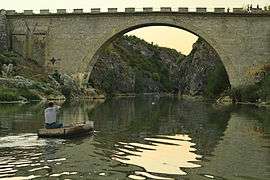White Drin
| White Drin Drini i Bardhë Beli Drim / Бели Дрим | |
|---|---|
 Waterfall at the mouth of the White Drin river | |
| Country | Kosovo[lower-alpha 1], Albania |
| Physical characteristics | |
| Main source | Žljeb mountain, north of Peja, Kosovo[lower-alpha 1] |
| River mouth |
with Black Drin forms the Drin, at Kukës, Albania 42°5′30″N 20°23′41″E / 42.09167°N 20.39472°ECoordinates: 42°5′30″N 20°23′41″E / 42.09167°N 20.39472°E |
| Length | 136 km (85 mi)[1] |
| Discharge |
|
| Basin features | |
| Progression | Drin→ Adriatic Sea |
| Basin size | 4,964 km2 (1,917 sq mi) |

The White Drin or White Drim (Albanian: Drini i Bardhë, Serbian: Бели Дрим / Beli Drim) is a river in Kosovo[lower-alpha 1] and northern Albania, a ca. 140-kilometre (87 mi)-long headstream of the Drin.
Course
Kosovo
The Kosovo section of the White Drin flows entirely in the semi-karst part of Kosovo, in an arc-shaped 122-kilometre (76 mi)-long course.[2] The river originates in the southern slopes of the Zhleb mountain, north of the town of Peja. The river springs near the Radavačka Cave. The cave is multi-leveled, not much explored and has a lake inside. The water from the spring was used by the Peć brewery. The stream is originally a sinking river which eventually springs out from the strong well and falls down as a 25-metre (82 ft)-high waterfall named the White Drin Waterfall near the village of Radovac, 8 km (5.0 mi) away from Peć. In 1934, Russian émigré Dimitry Tyapkin projected and constructed a hydroelectric power plant next to the waterfalls which produced electricity for the town.[3]
The White Drin first flows to the east, next to the spa of Banja e Pejës, and the villages of Banje, Trbuhovac and Zlakućan, where it receives the Istočka river from the left and turns to the south. The rest of the course is through the very fertile and densely populated central section of Kosovo(Podrima region), but oddly, there is not even one large settlement on the river itself, despite many smaller villages on the river. The largest cities are kilometers away from the river (Peja, Gjakova, Prizren) whilst some smaller towns (Klina) and large villages (Krusha e Madhe, Gjonaj) are closer to it. The White Drin also creates the small White Drin Canyon in Republic of Kosovo.
The White Drin receives many relatively long tributaries: Pećka Bistrica, Dečanska Bistrica, Prue potok, and Erenik from the right; Istočka, Klina, Mirusa, Rimnik, Topluga and Lumi I Prizrenit from the left.
The Kosovo part of the White Drin basin comprises 4,360 km2 (1,680 sq mi). Here the waters of the river are used for waterworks of the big nearby towns, irrigation and power production (especially its right tributaries). At the Vrbnica-Shalqin border crossing, the river enters the eastern Albanian region of Trektan.
Albania
The Albanian section of the river is 16 km (9.9 mi) long[1] with the drainage area of 604 km2 (233 sq mi). There are no settlements on the river and it receives the Lumë river from the left (which also originates in Kosovo, from several rivers in the region. Finally, the White Drin reaches the town of Kukës where it meets the Black Drin and forms the Drin, which flows into the Adriatic Sea; thus the White Drin belongs to the Adriatic Sea drainage basin. The river is not navigable.
The entire Albanian section (and part of the Kosovan) is flooded by the artificial Fierza lake (see Drin controversy).
Notes
- 1 2 3 Kosovo is the subject of a territorial dispute between the Republic of Kosovo and the Republic of Serbia. The Republic of Kosovo unilaterally declared independence on 17 February 2008, but Serbia continues to claim it as part of its own sovereign territory. The two governments began to normalise relations in 2013, as part of the Brussels Agreement. Kosovo has received formal recognition as an independent state from 113 out of 193 United Nations member states.
References
- 1 2 3 Drin/Drim River Sub-basin
- ↑ http://www.ammk-rks.net/repository/docs/Resurset_ujore_te_Kosoves.pdf
- ↑ Dr Branislav Nikolić, "Vodopad na izvoru Belog Drima", Politika (in Serbian)
- Jelena Bosnić; Milosav Mirković (1997). Tajni teret. ISBN 978-86-07-00001-2.
- Jovan Đ. Marković (1990): Enciklopedijski geografski leksikon Jugoslavije; Svjetlost-Sarajevo; ISBN 978-86-01-02651-3
| Wikimedia Commons has media related to White Drin. |